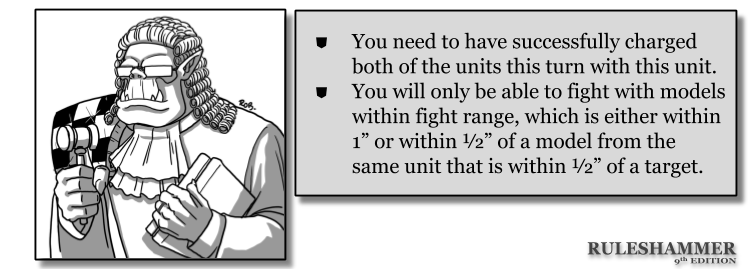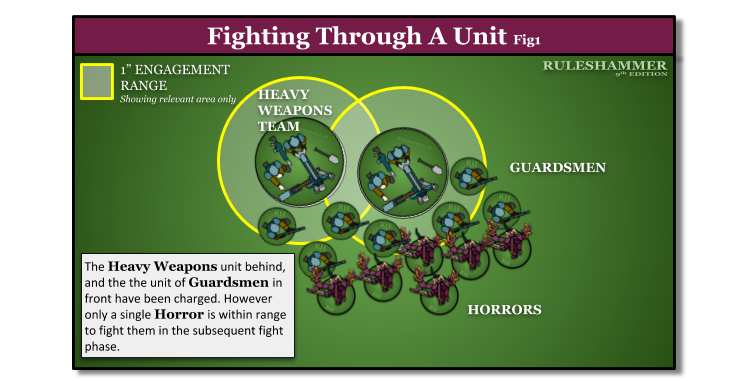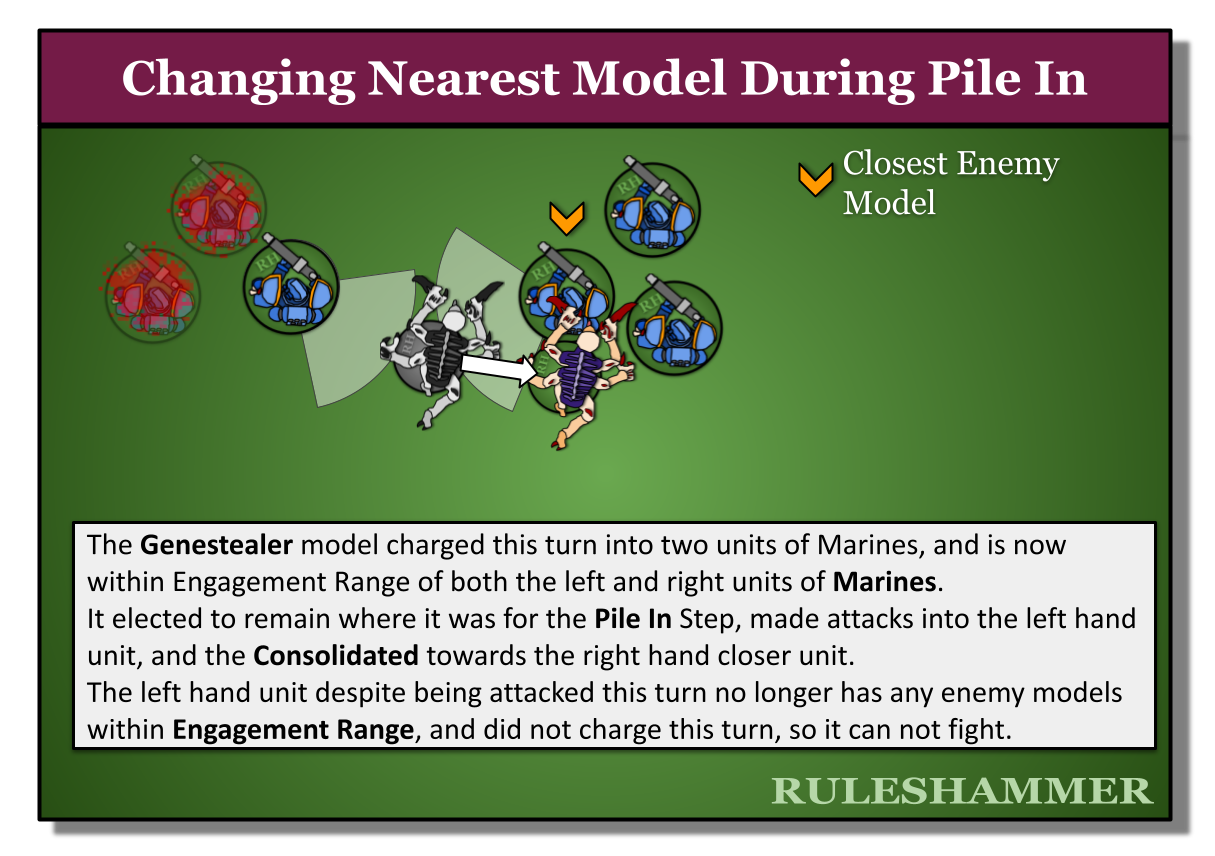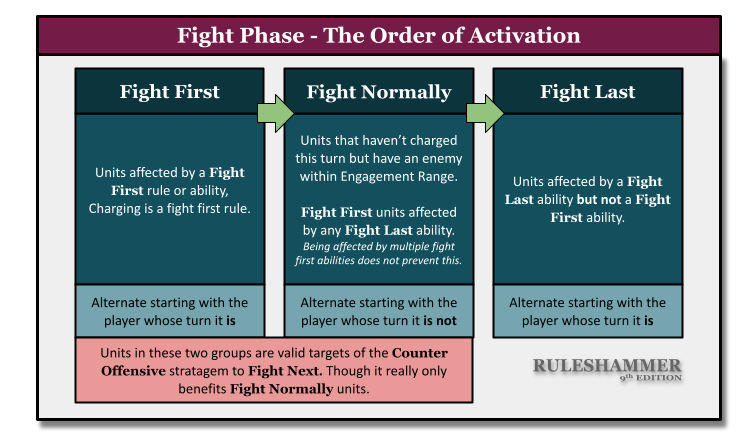Welcome to Ruleshammer! This article covers the Fight Phase, the basics and common things to look out for. Remember the banner below will take you to the Ruleshammer 9th Edition Compedium, for all the questions I’ve answered for the last few months!
What does “to Fight” mean in Warhammer 40k?
One of the key mistakes made by experienced and new players alike is confusing “fight” with “making attacks” during the phase. Some of this is based on how earlier versions of the game ordered this phase, and some of the confusion arguably stems from using the word “fight” in the first place. So what does it mean? Let’s look at the rules:
When you select a unit to fight, it first piles in, then the models in the unit must make close combat attacks, and then the unit consolidates.
Fighting in the Fight phase isn’t just rolling attacks, it’s a three-part sequence of actions. Importantly, this means that a unit can “fight” and still have fought even if it made no attacks. Any unit that activates in the fight phase gets to make a Pile in move, make attacks, and then consolidate, and then it is considered to have fought. This can come up with units which declared a charge and end up with no enemy units in Engagement Range when they activate (usually because the unit they charged was destroyed before they got to activate) – these units can still Fight, making pile-in and consolidate moves toward the nearest enemy unit.
These rules can also come into play with rules that allow a unit or model to fight “on death,” and these rules typically require that the model not already have fought:
Death Frenzy: Each time a model in this unit is destroyed by a melee attack, if that model has not fought this phase, do not remove it from play. The destroyed model can fight after the attacking model’s unit has finished making attacks, and is then removed from play.
In these cases, if a model’s unit has fought, then the model counts as having fought, even if it made no attacks during that Fight activation.
Who can Fight?
There are two factors which can make a unit eligible to fight, i.e. be activated in the Fight phase:
Starting with the player whose turn is not taking place, the players must alternate selecting an eligible unit from their army and fighting with it (see below). An eligible unit is one that is within Engagement Range of an enemy unit and/or made a charge move in the same turn. If neither player has any eligible units to fight with, the Fight phase ends.
Units that Charged can always fight, even if there are no unit within Engagement Range. Units that didn’t charge though need to have an enemy unit within Engagement Range at the moment you want to fight with them, this means units can enter and leave eligibility during a turn if units around them move or are destroyed.
Rob: This is a good one to remember – it’s possible to pull enemy units out of eligibility by pulling casualties from your units in such a way that no models are left within Engagement Range of those units. This can be helpful if your opponent has multiple units they want to activate. You can also do this with your pile-in or consolidation moves in some situations.
Piling In
Fighting starts with Piling In. Usually this is a 3″ move that must end closer to the nearest enemy model (you don’t have to move directly in their direction, just get closer).
PILE IN
When a unit piles in, you can move each model in that unit up to 3″ – this is a pile-in move. Each model in the unit must finish its pile-in move closer to the closest enemy model. A model that is already touching an enemy model cannot move, but still counts as having piled in. Remember that a unit must finish any type of move in unit coherency.
There’s a few key features to note though:
- Models that are in base to base contact with an enemy model can’t pile in further (or move at all) because it’s impossible to get models closer than touching base to base. You can’t end a move closer than “as close as possible” so there’s no legal move for them to make.
- It’s a PER MODEL check for the nearest enemy model, and no distinction is made for visibility. For most of a unit this will be the same but in a large melee of multiple units the unit can feel pulled in several directions. You don’t have to move every model though, so you can leave models still to maintain coherency with the models moving towards their closest enemy model.
- FLY does not function for Pile In Moves or the Fight Phase at all. You can’t use it to Pile In over another model.
- Difficult terrain does not slow Pile In moves.
- You CAN move within Engagement Range of enemy units during a Pile In. Unlike the Movement and Charge phases where moving within Engagement range is either not allowed or only allowed for charge targets, Pile In moves are not subject to this limit. This does allow those enemy units to fight though if they are still within Engagement Range later in the phase (provided they haven’t already fought). Also remember that units that Charged this turn can only target units they declared as a targets of the charge, or enemy units which Heroically Intervened, so if you pile into a unit you didn’t charge you won’t be able to allocate attacks to that unit this turn.
With Pile In moves complete it’s time to look at who can attack.
Who can make attacks?
There are two distinct ranges at which a unit can make attacks. The first range is Engagement Range. Engagement Range is a 1″ horizontal range around all enemy units (there’s a vertical component . Presuming that the target is a valid one (see the Charge Phase) a model within Engagement range of the enemy can make attacks.
Second, units which are within a ½” of a friendly model in their own unit that is itself within ½” of an enemy unit can make attacks. Lets see what that looks like with a diagram:
Compared to previous editions this is a bit tighter than it’s been in the past pretty much limiting most fights to two “ranks” of combatants on any base size.
Vertical Distances and Engagement Range
Depending on your table, you might have ruins with upper floors, with units fighting and moving between them. Engagement Range takes this into account – units are in Engagement Range of an enemy unit if they are within 1″ horizontally and 5″ vertically, so a model can fight an enemy unit on the floor above if the distance between floors is 5″ or less. Note that these distances are measured between the model’s bases and not the top of a model.
Finally note that there is no exemption for models outside Engagement Range when talking about vertical distances, i.e. a model within ½” of a friendly model that is within ½” horizontally of a model on the floor above won’t get to fight as the rules don’t specify a vertical distance component.
All Attacks Must Be Made
Unlike in the Shooting phase where a model eligible to shoot can elect not to shoot with one or more of its weapons, in the fight phase if a model can make attacks then you have to declare a target for all of the attacks it can make.
MAKE CLOSE COMBAT ATTACKS
When a unit makes its close combat attacks, before resolving those attacks you must first determine which models can fight and how many attacks they will make, then you select the target unit(s) for all of the attacks those models will make and declare what melee weapons those attacks will be made with.
Not that you won’t want to make them often, but there might be some occasions where leaving a unit partially alive is better than dead. Perhaps a secondary for an enemy failing morale? Or you’re hoping to keep the unit in combat so that your units can’t be shot at next turn. Unfortunately you can’t bring about those favourable outcomes but deciding to not attack, though you can control how many models will attack to some extent with the charge and pile in moves.
The Close Combat Weapon
Unlike previous editions where every model was equipped with the basic Close Combat Weapon, with Strength User, no AP, and 1 damage. In 9th edition only models that either have no other melee weapons OR can’t use them, can make use of the Close Combat Weapon Profile.
If a model is not equipped with any melee weapons, or if it cannot make an attack with any of the melee weapons it is equipped with, then that model makes its attacks using a close combat weapon, which has the following profile:
Consolidate
Finally the activated unit Consolidates. Players of older editions of 40k and even the newest edition of Horus Heresy can often forget that this is now a per-unit part of the order. It doesn’t happen after all fights, it happens after a single unit has made attacks. Similar to to the Pile-In Move it’s generally a 3″ move again that must end closer to the nearest enemy model.
CONSOLIDATE
When a unit consolidates, you can move each model in the unit up to 3″ – this is a Consolidation move. Each model must finish its Consolidation move closer to the closest enemy model. A model that is already touching an enemy model cannot move, but still counts as having consolidated. Remember that a unit must finish any type of move in unit coherency.
A lot of the same features to note of Pile-In Moves are true of Consolidation: units in base to base contact can’t move, it is also a per model check, FLY also does nothing, it can be used to move within and end moves within Engagement Range of enemy models. Bear in mind that if you consolidate into Engagement Range of a unit that has not fought this turn you will make that unit eligible to fight. In this way some units can actually end up Fighting after units affected by fight last abilities. A situation which leads conveniently into the elephant in the room of the Fight phase.
Who Fights Next?
Fight Order has has a tumultuous history in 8th and 9th but we are finally are an almost reasonable level of complexity summarised by this chart, which is itself a summary of this Designer Commentary:
That’s essentially the whole thing, there are of course still some edge cases. Abilities such as Death Guard Stench Vats are an example of one such interaction, in that they have a unique way of interacting with the Fight First and Fight Last rules.
Other Interactions of Note
Can I fight “through” an Enemy Unit?
Potentially yes, though there’s a super specific set of positions required that make it unlikely to be possible every game. The criteria for a successful charge (as detailed above) make this situation unlikely but not impossible. If your unit charged this turn then to be able to fight a unit behind another you need to meet these criteria: So you could feasibly charge and manage something like this:
So you could feasibly charge and manage something like this: Generally gaps like this will not be common, and pile in will usually not let you move around the front unit too far because you must move towards the nearest enemy model when doing so.
Generally gaps like this will not be common, and pile in will usually not let you move around the front unit too far because you must move towards the nearest enemy model when doing so.
Fighting Through a Wall
As covered more extensively in my article on charging, Ruins can present significant barriers to close combat. However bear in mind that their is no line of sight requirement for close combat attacks, so if you do end up in a situation like this charge below, those units could fight through the wall.
Fighting Over a Barricade
Barricades are a type of terrain that change some aspects of determining eligible units. It’s important to note what they do and don’t adjust though, important Engagement Range is not actually changed but an additional criterion for fighting is added.
 Have any questions or feedback? Got a rules question you want answered? Drop us a note in the comments below, ask a question in our Ruleshammer form, or head over to r/ruleshammer to discuss.
Have any questions or feedback? Got a rules question you want answered? Drop us a note in the comments below, ask a question in our Ruleshammer form, or head over to r/ruleshammer to discuss.






